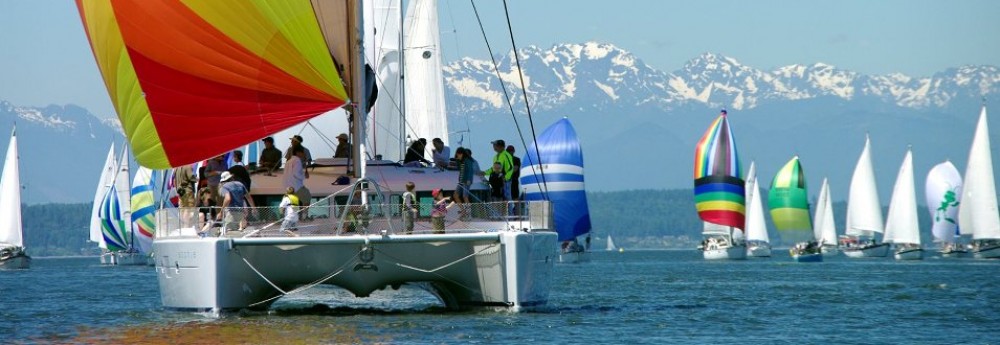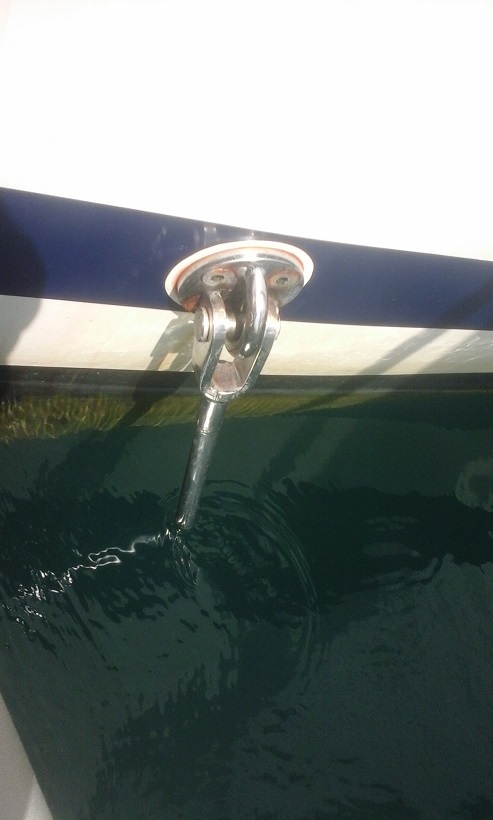As I mentioned yesterday, we broke the cable that connects the bowsprit to the starboard hull. In this photo, you can see how the cable on the port side looks.
Here is a photo that shows how the end of the cable attaches to the starboard hull. This fitting is called a swage, and it is intact. Please accept our apologies for the moss growing on Sophie’s waterline, it was totally clean 2 weeks ago. (Thanks for the muck, Jayapura!)
Here is a photo of the swage after I removed it from the fitting on the starboard hull. It is hard to tell in this photo, but there is a slight bend to the swage.
Now let’s get to the money shots.
 Here is a photo of the inside of the swage. You can see the cable has snapped off at the end of the swage. The three inner strands of the cable are rusty.
Here is a photo of the inside of the swage. You can see the cable has snapped off at the end of the swage. The three inner strands of the cable are rusty.
Here is the other end of the cable. The strands did not break off uniformly. There is no fraying. The three inner strands are rusty.
So …what happened? Do you think it broke due to minor corrosion combined with ongoing wave action? Or do you think we hit something like a log? Or was the cable a victim of a shark attack?
We welcome your thoughts…





The bend in the swage fitting is very… weird. If not for that it would seem a simple rust-induced failure.
Jamie, I think you have stainless in an anaerobic environment (inside the swage) + saltwater (bow, where waves kick up) + warm environment (accelerates chemical reactions) + work hardening (transition from hard swage to softer cable, lots of flexing loads when bows hit waves) = snap. Time to thoroughly inspect everything, and consider replacing with high modulous aramid like amsteel (lighter, can’t corrode)
It’s pretty disconcerting when that happens. Wondering how old the rigging is? I just replaced the entire standing rig on my boat and what otherwise looked to be in excellent condition, we found numerous hidden issues. But the rigging was well over its 10 year life expectancy. So perhaps an older rig? Maybe it was an anomalous metal failure? And dare I ask (since I have no cat experience above 18 feet) could there be any flex between the hulls that fatigued that fitting? Very curious. I wish you the best of luck on a resolution.
Bigfoot strikes again!
Thanks for the input. There is one thing I didn’t make clear in the post: unless we have the code zero mounted, there is no structural load or tension on the cable. There was no halyard or forestay attached to the bowsprit, so underway the cable actually looks like the port cable in the opening photo. It’s been in this loose configuration for the last 1,000 miles. It does experience some tension from the drag of the of the waves pushing against it, and this drag is magnified by the additional drag of the anchor bridle resting against cable. But there was no structural load or flexing involved (and ALL catamarans flex).
I think minor corrosion + log. LOTs of logs around here.
Hi James. If I read you correctly, the rigging component failed under no load ? Remind me when Sophie was built please. Thanks, Kent.
Yup, no load. Hence my theory about a collision.
2007
The location of that swage fitting would make it subject to an earlier than usual failure. I like the suggestion of replacing those stays with something like Dyneema. What diameter are the wires?
Dear Jamie:
Yesterday I tried to reply but it did not work.
Alex is correct. Regular SS does not like an anaerobic environment. Lack of Oxygen is hurtful for SS. The tip off is indicative of rust at the cable. SS shafts for propellors need
a special alloy to prevent the problem at the strut. This is why we use Monel. This is also the reason why through hull fittings are never made of SS. Good old Bronce or plastic.
Love your blogs.
Dad (retired consultant)
PS Stay well
Sent from Windows Mail